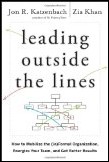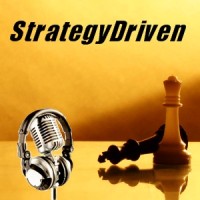Recommended Resources – An Interview with Jon Katzenbach and Zia Khan, authors of Leading Outside the Lines
Leading Outside the Lines: How to Mobilize the Informal Organization, Energize Your Team, and Get Better Results
by Jon Katzenbach and Zia Khan
Every enterprise has an informal as well as a formal organization. The formal is the side with which business people are usually most familiar. It consists of analyses, strategies, structures, processes and programs – all codified in memos, charts and Power-Point presentations. These tools are designed to align decisions and actions. The informal is generally less familiar. It consists of emerging ideas, social networks, working norms, values, peer relationships and communities of common interest – the elements that often hide beyond the boundaries of the formal. In Leading Outside the Lines, authors Jon Katzenbach and Zia Khan make the compelling case that it is in the less familiar informal world where magic happens… yet one without the other is unlikely to sustain peak performance over time.
Additional Insights… An Interview with Jon Katzenbach and Zia Khan, authors of Leading Outside The Lines
StrategyDriven Contributors recently interviewed Jon Katzenbach and Zia Khan, authors of Leading Outside the Lines; receiving many invaluable, beyond the scope of the book insights.
SD: Why did you write Leading Outside the Lines?
JK and ZK: To help leaders gain a powerful performance ‘boost’ from their informal organizations. In our years helping leading organizations improve performance, we’ve learned that leaders at all levels have a difficult time with, or don’t realize they need to address, a key avenue to success: balancing two distinct dimensions of human behavior and organizational performance – the formal and the informal elements. Learning how to mobilize the informal elements of an organization to accelerate the formal elements goes a long way in helping leaders fill the gap between intention and results. Further, the recession and slow recovery have forced many organizations to reduce headcount to a bare minimum, and have undermined employee motivation. Without making changes to headcount, systems of performance management and processes, leaders can tap into the informal elements of the organization to realize additional performance potential, and do so ‘for free.’
SD: What is the ‘informal organization?’ And what is the ‘formal?’
JK and ZK: The informal unlocks the emotional side of behavior; the formal is the rational side. The informal organization is a bundle of organizational elements that are often hidden from view, but exert strong influence on people’s decisions and behaviors. The informal includes values that drive decisions, networks that guide personal interactions and the spread of information and emotional feelings about the work that drives the amount of effort and commitment that people put into their jobs. The formal organization, on the other hand, includes the codified elements of organization that are usually disseminated on paper. They include strategies, structures, processes, metrics, etc. In other words, the informal organization is comprised of interpersonal connections, influences and “rituals” that happen beyond, around and beneath the formal rules; they are seldom codified or reference-able. The formal is the structural lines, boxes, rules, measures and processes that describe how things are supposed to work; they are almost always codified and reference-able.
SD: What do you mean by ‘Leading Outside the Lines?’
JK and ZK: Influencing results by using informal mechanisms beyond the hierarchy. The lines represent the formal organization – the usual elements of strategy, structure, hierarchy, metrics, etc. Most effective leaders are well trained in using those elements. However, the best leaders also learn how to mobilize the informal organization – the values, networks, and sources of pride that drive motivation and high performance. These elements are more responsive to leadership outside the lines, so to speak. So, leading outside the lines is really stepping outside of formal roles and responsibilities to influence emotions that accelerate behaviors that determine performance.
SD: Why is the ‘Leading Outside the Lines’ concept and call to action any more important now than it was, say, five years ago?
JK and ZK: The recessionary recovery challenge demands emotional as well as rational leadership capabilities. There are two reasons. First, managing the formal organization has become a widespread and broadly used discipline. In the past, optimized processes and fact-based strategies gave companies an advantage. Now, anyone can buy them off the shelf, so it’s hard to gain a competitive advantage through formal elements alone. The informal organization, however, is mostly uncharted territory. There’s lots of excitement about social networking and the like, but there aren’t many practical frameworks or approaches for using informal elements to gain performance advantages. And the advantages gained from the informal organization are very, very hard to copy. Second, as mentioned before, because of the recession and slow recovery, most companies are in much greater need of leadership capacity that both the formal and informal organizations provide.
SD: You say that if the informal isn’t working for you, it’s working against you. What do you mean by that?
JK and ZK: Informal forces are always at play – you cannot simply turn them on and off by command. The informal is working all the time: It’s not ‘stoppable or start-able;’ it’s only influence-able. It either resists and de-rails what the formal is trying to accomplish, or it supports and accelerates it. It is never ‘in neutral.’ So, the chances that the informal organization is working for you without any deliberate attempt to mobilize it in the right direction are fairly low. In many cases, when left unattended, the informal works against you even if you’re not trying to change anything. In fact, the informal organization can align itself in the opposite direction that leaders want to take the whole company if the informal organization hasn’t bought into the change.
SD: What are the results when leaders successfully balance the informal with the formal?
JK and ZK: Emotional commitment supplants rational compliance to optimize performance results. Overall, leaders can accelerate performance results by combining the best of both the informal and the formal, and do so without having to make trade-offs. They get the efficiency of the formal with the creativity of the informal; the focused execution of the formal with the responsiveness to new opportunities of the informal; the accountability of the formal with the emotional commitment of the informal. In other words, you get behavior change that yields higher performance results or faster results – and often BOTH!
SD: You tell a lot of stories in the book. What’s your favorite one?
JK and ZK: We don’t have a single favorite; it depends on the issue. We like all the stories, and there are different categories. Perhaps our favorite ‘informal miracle’ story is the one about the transformation of Aetna. Early in the decade, Aetna had been on a treadmill to nowhere – even though it had tried three different change programs. It continued to lose $1 million a day. But a new CEO, Dr. John Rowe, had a vision to turn it all around – by bringing the company’s pride back. He engaged all levels of the informal organization and created evangelists for formal change. The core of the program was known informally throughout the company as ‘restoring the pride.’
SD: You mention types of workers call ‘fast zebras.’ Who are they? What do you do with them?
JK and ZK: People who get important stuff done quicker by going down informal as well as formal paths. In the wild, the fast zebra gets to the watering hole quickly and escapes predators who might be waiting. Similarly, in organizations, there are those who can quickly find innovative ways to realize their objectives without getting bogged down by organizational predators like bureaucracy, politics, senseless policies, outdated rules, etc. They have learned how to get things done by using a dynamic variety of formal and informal mechanisms; they know when to follow the rules, when to bend the rules and when to change the rules. The best thing to do with them is to learn from them, and draw on those learnings to make changes to the organization so you can enable potential fast zebras. Give them room to interact, get them together to energize one another and listen to – and act on – their insights.
SD: What kinds of leaders are best at ‘Leading Outside the Lines?’
JK and ZK: Those who have learned the power of the informal through trial and error. They are very open to the informal – and realize they don’t have all the answers. They are willing to take personal risks by drawing on emotional intelligence as much as analytical intelligence. They spend time with people at any level, particularly the frontline, and not just with a select few at headquarters. Most importantly, they believe that while the informal organization may appear to be unruly chaos and resistant to control, they know it can be mobilized to generate real performance results.
SD: What are the biggest mistakes leaders make when trying to manage and maximize the informal organization?
JK and ZK: The biggest mistake is to try and manage the informal like the formal. It can’t be told what to do; it must be convinced, influenced and energized. We tell clients that they must mobilize the informal and manage the formal. Therefore, it’s a big mistake to think that top-down communication will keep the informal interactions positive. It’s also a mistake to believe that broad-based ‘engagement scores’ are indicative of informal support and to underestimate the importance of emotional commitment over rational compliance.
SD: Are you saying that strict ‘traditionalists’ will fail in this environment?
JK and ZK: Only if you define under-performance as failing. They won’t actually fail – and that’s part of the problem. Right now, any leader who can’t use the formal organization has a very short career. So they get weeded out quickly. However, those who don’t use the informal will usually accomplish good enough results, as there aren’t many who know how to use both and who achieve outstanding results. However, we expect that as the discipline of using the informal spreads, the pressure to be versed n it will increase. We do believe that those who only take advantage of one side of the “organizational brain” will fall short of their potential – and end up as mediocre guardians of the status quo.
SD: What happens if a leader backs off from the informal organization and just lets it grow organically?
JK and ZK: He competes with one hand tied behind his back. It would be the same as forgetting about marketing and hoping your customers buy your products by chance. It’s an asset that needs to be used with purpose. It may adapt to support you organically if you have effective and committed leaders down the line, but it can also align against you if you change the status quo to which it has evolved. Remember, the informal organization has a mind of its own, which may not be in sync with your priorities. More often than not, when left to evolve on its own, the informal organization works against you. Put another way, it would be analogous to letting ivy find its own home.
SD: Your book mentions ‘master motivators’ and ‘pride builders.’ Who are they, and what do you do with them?
JK and ZK: They are people in supervisory situations who know how to make others ‘feel good’ about the work that has to get done every day; they instill pride in the work itself. We use these terms inter-changeably. We urge leaders to listen and learn from them, and get them into networks and communities where they can spread motivational skills experientially among peers and colleagues. The people who work for them ‘never want to disappoint them’ and the people who work beside them want to learn their ‘secrets.’
SD: What can leaders do to get better at actively leveraging the informal and balancing it with the formal?
JK and ZK: Keep working at it; if at first you don’t succeed, try and try again. The first thing is to get an understanding of your current informal organization – the values, the networks and sources of pride. Front line leaders can seek out peers who are natural pride-builders; leaders at the top can find ways to connect with them, learn from them, and spread their behaviors; leaders in the middle can do both.
About the Authors

, Peak Performance
, Why Pride Matters More Than Money
, and the new Leading Outside the Lines
. He received his MBA from Harvard, where he was a Baker Scholar. Jon is a founding partner of Katzenbach Partners. To read Jon’s complete biography, click here.

, is vice president for strategy and evaluation at the Rockefeller Foundation, which supports innovations that help people share globalization’s benefits more equitably and strengthens their resilience to social, economic, health and environmental challenges. Zia also advises leaders on the integration of strategy and organization as a senior fellow of the Katzenbach Center, which he co-founded with Jon Katzenbach, and as an individual consultant. Prior to joining the Rockefeller Foundation, Zia established and led Katzenbach Partners’ San Francisco office and West Coast Practice and pioneered the firm’s work on the informal organization. Zia hold a B.S. from Cornell University and an M.S. and Ph.D. from Stanford University. To read Zia’s complete biography, click here.


 Robert Thompson is the author of
Robert Thompson is the author of  StrategyDriven Podcasts focus on the tools and techniques executives and managers can use to improve their organization’s alignment and accountability to ultimately achieve superior results. These podcasts elaborate on the best practice and warning flag articles on the StrategyDriven website.
StrategyDriven Podcasts focus on the tools and techniques executives and managers can use to improve their organization’s alignment and accountability to ultimately achieve superior results. These podcasts elaborate on the best practice and warning flag articles on the StrategyDriven website.
 David Axson, author of
David Axson, author of  At one time or another, we have all been told that we should use the right tools for the job. And it’s easy to understand how using the proper tools and possessing the appropriate skills helps a given assignment proceed at optimal efficiency; which is also to say at the lowest cost.
At one time or another, we have all been told that we should use the right tools for the job. And it’s easy to understand how using the proper tools and possessing the appropriate skills helps a given assignment proceed at optimal efficiency; which is also to say at the lowest cost.